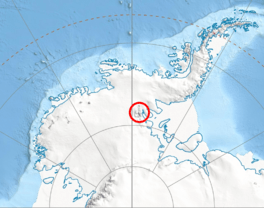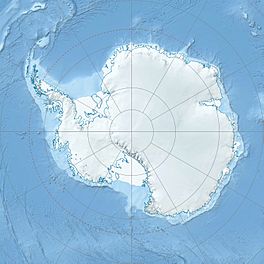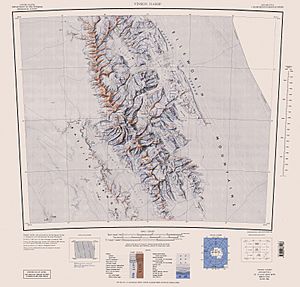Hansen Glacier facts for kids
Quick facts for kids Hansen Glacier |
|
|---|---|

Location of Sentinel Range in Western Antarctica
|
|
| Location | Ellsworth Land |
| Coordinates | 78°21′00″S 84°33′00″W / 78.35000°S 84.55000°W |
| Length | 10 nautical miles (19 km; 12 mi) |
| Thickness | unknown |
| Terminus | Dater Glacier |
| Status | unknown |
The Hansen Glacier is a long river of ice found in Antarctica. It is about 10 nautical miles (which is about 18.5 kilometers or 11.5 miles) long. This glacier flows towards the northeast.
It starts near Mount Tuck and moves between two areas called Veregava Ridge and Doyran Heights. The Hansen Glacier eventually joins up with another glacier, the Dater Glacier. This meeting point is located west of Dickey Peak. All these places are part of the Sentinel Range in the Ellsworth Mountains of Antarctica.
Where is Hansen Glacier Located?
The Hansen Glacier is in a very cold part of the world: Antarctica. Specifically, it is in a region known as Ellsworth Land. This area is famous for its large mountains and glaciers.
The Sentinel Range is a major mountain range in Antarctica. It includes some of the continent's highest peaks. Glaciers like Hansen Glacier flow through these mountains.
How Was Hansen Glacier Discovered and Named?
The Hansen Glacier was first mapped between 1957 and 1959. This mapping was done by the United States Geological Survey (USGS). The USGS is a science agency that studies the Earth.
They used information from ground surveys. They also used photos taken from planes by the United States Navy. These air photos helped them create detailed maps of the area.
The glacier was named by the Advisory Committee on Antarctic Names. This committee is in charge of naming features in Antarctica. They named it after Herbert L. Hansen. He was a meteorologist, a scientist who studies weather. Herbert L. Hansen worked at the South Pole Station in 1957.



